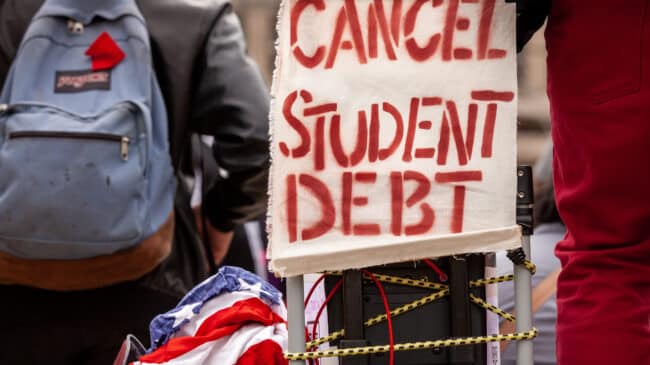Many of the 43.3 million Americans with federal student loan debt totaling $1.61 trillion have anxiously anticipated President Joe Biden’s decision about student loan forgiveness.
Last week, The Washington Post reported that the president’s plan, which sources say is nearing a formal announcement, will resemble his 2020 campaign promise to forgive $10,000 in federal student loans per borrower. The Committee for a Responsible Budget estimates this will cost taxpayers $230 billion.
While political firebrands such as Sen. Bernie Sanders have long supported substantially increasing federal higher education spending, including offering things like free college, President Biden’s proposal would represent a significant change in policy from previous presidential administrations, including Democrats.
President Barack Obama’s 2008 campaign promises were modest by comparison. President Obama sought to expand Pell Grant access to low-income students and eliminate government subsidies to private student lenders. Even Obama’s 2014 executive order that sought to forgive some federal student loans only did so after 20 years and required borrowers to make regular payments via the Pay As You Earn Initiative.
By comparison, the Biden administration’s plan is a major departure from Obama’s more modest and measured approach to student debt. While it would certainly be popular with many of the people who have $10,000 of their student debt forgiven, public opinion is quite divided over how to handle college student debt.
A CNBC national poll conducted in January of 2022 found that 34% of respondents supported loan forgiveness for all student loans. Only 27% of respondents opposed student loan forgiveness entirely. However, 35% of respondents supported a middling approach, preferring loan forgiveness only for those “in need.”
Supporters of student loan forgiveness for those in need may be pleased to hear that President Biden’s proposal is reportedly going to be means-tested, with individuals eligible for student loan forgiveness if they have an income of less than $150,000 ($300,000 for couples).
The Washington Post editorial board notes some of the problems with that cut-off:
These provisions, while welcome, would not stop the policy from becoming yet another taxpayer-funded subsidy for the upper middle class. The president’s means test would be almost useless, as some 97 percent of borrowers would still qualify for forgiveness. The Committee for a Responsible Federal Budget, a nonpartisan watchdog, estimates that such a plan would cost at least $230 billion, that 71 percent of the benefits would flow to those in the top half of the income scale — and that a quarter of the benefits would go to the top 20 percent. Even this does not express fully how regressive the policy would be, because many recent graduates from medical, law and business schools would qualify for forgiveness even though their lifetime income trajectories don’t justify it.
Similarly, The Wall Street Journal has reported that more than 40% of all student loan debt is held by individuals with advanced and lucrative degrees, such as doctors and lawyers.
Only one-third of Americans have bachelor’s degrees. These individuals are statistically likely to earn more than the two-thirds of Americans who don’t have those credentials.
This means that many taxpayers nationwide, 85% of whom do not have student loan debt, would now be paying off the student debt of their college-educated peers who, in many cases, enjoy greater affluence because of their college degrees.
Importantly, this loan forgiveness proposal does not actually address the major problem of rising college costs. Biden’s plan would likely only exacerbate what many have labeled the student debt crisis.
The American Enterprise Institute’s Beth Akers points out that there will definitely be a change in borrower behavior after any sort of debt reduction. She wrote:
“Economically rational people will respond to that dynamic by choosing more expensive programs of study and borrowing more than they would have otherwise. The result: a pool of outstanding student debt growing even more quickly than before.”
This means that Biden’s proposal would incentivize future students to invest in riskier loans under the hope or assumption that their loans could later be forgiven. Such a plan is a disaster in the making that, over the long-term, could significantly expand Americans’ already ballooning student loan debt.
In fact, even if President Biden does reduce student loan debt by $10,000 per borrower, the Committee for a Responsible Budget reported that the total student loan debt would return to its current level in just three years, assuming no change in borrower behavior.
Instead of debt reduction, policymakers should consider reforms that have a lasting effect and address the rising cost of college. Extricating the federal government from the student loan business altogether or placing strict annual and lifetime caps on federal student loans could help encourage universities to stop hiking their costs.
At the end of the day, any sort of student loan forgiveness is a bad policy since it does not hold individuals accountable for their financial decisions. In fact, it would represent a massive betrayal of public trust. Many people worked to pay off their student loans. Others chose less expensive colleges to avoid student debt. Some people didn’t go to college at all because they decided they couldn’t afford it.
It may be well-intentioned, but President Biden’s student loan forgiveness plan is a recipe for disaster. It would potentially encourage bad borrowing behavior going forward. It would disadvantage those who made significant sacrifices to avoid or minimize their student debt. And, perhaps worst of all, it would force American taxpayers who didn’t go to college to pay for student debt they chose to not accrue and from which they will not benefit.

